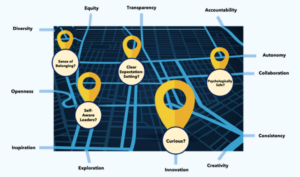
How to Get Your Workforce On Board With AI
The push/pull challenge of change management is never easy to embrace. After all, resisting disruption is human nature. But the process of unlearning and relearning

The push/pull challenge of change management is never easy to embrace. After all, resisting disruption is human nature. But the process of unlearning and relearning

Is concern over employee loyalty keeping you up at night? You’re not alone. Here’s one recent scenario: An executive team at a large healthcare system

Today’s workforce is rapidly changing, as Boomers pass the baton to their Gen X, Millennial, and Gen Z counterparts. However, for many organizations, this transition

Driven by an ever-growing desire for personalized, convenient, seamlessly integrated experiences, customer expectations continue to evolve at breakneck speed. To meet these expectations, organizations must

People often assume happy employees are also engaged. But is that really a safe bet? Sometimes with the best intentions to improve happiness in the

Recently, I was talking with a dear friend who was about to interview a candidate she had unknowingly placed in a professional reputation “box”. The

Let’s go back in time. Way back to 1997. Apple’s high-flying identity as a tech innovator had been seriously tarnished. It certainly wasn’t the global

Sponsored by The Culture Platform What makes maps so special is they tell you exactly where to find places you want to visit. Wouldn’t it

Anyone who says being a leader is easy is simply not being honest. Leadership is hard. Yes, I said it. And that shouldn’t shock anyone.

Imagine this: You’re attending one of your company’s senior staff meetings. The CEO nods and smiles when one executive shares a KPI chart with an

Human resources can be a highly rewarding profession, especially at technology startup companies. In fact, recent research says effective human resources management actually helps drive

One of your employees just handed you a resignation letter. What happens next? Are you prepared to set your company’s offboarding wheels in motion? Situations

In our constantly changing business environment, one thing remains the same — employees want to hear from their organization’s leaders. People naturally look to decision-makers

You’re a business leader. You believe in your company with all your heart. Your commitment to the organization’s mission drives you to aim high, work

Management advice is everywhere. But how do you know which guidance to trust? To find truly useful answers, we asked business executives to answer this

In today’s fractured, post-pandemic world, workforce mental health has emerged as a critical concern for business and HR leaders — and with good reason. The

A fine mechanical watch is exquisite in its own right. But if you look closer, you’ll see more than just a special timepiece. It is

We often hear that people don’t leave jobs, they leave managers. We all get what that means. But what does it mean for those of

Leaders, do workforce engagement issues keep you up at night? If not, here’s a powerful wake-up call from Gallup. Last year, the global employee engagement

These days, any employer that doesn’t lead with purpose is fighting an uphill battle. Why? Take a look at recent headlines. They’re filled with news

In less than 20 years, podcasting has revolutionized the way we consume and engage with informational content, offering a powerful digital platform for individuals to

Are you disturbed by news about organizations backtracking on workplace diversity and inclusion commitments? I certainly am. For example, a recent Wall Street Journal article

Sponsored by The Culture Platform What tools actually help managers manage their people? That’s the most important question every organization needs to ask itself as the

If pay transparency isn’t yet a hot topic in your organization, it soon will be. Recently, several states have passed pay transparency laws, and others

No question about it. Strong internal communication is critical to a strong business. But it’s not easy — especially when workplace dynamics are constantly fluctuating.